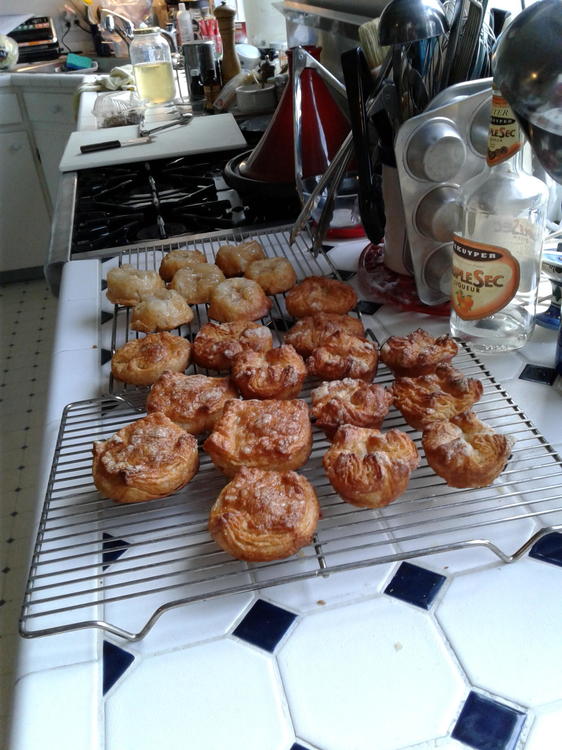
boilsover
participating member-
Posts
918 -
Joined
-
Last visited
Content Type
Profiles
Forums
Store
Help Articles
Everything posted by boilsover
-
You're kidding, right? I must've missed that section of the rulebook. They were cut to 4x4" squares. If you really care, you can tote up the weights from the prep---it can be found at p. 299 of David Liebovitz's most recent book, L'appart. There were a few errant grains of sugar, so I'm sure my results are untrustworthy... No, I used it the same way I would have used a smooth pin--if only because that's all I knew to do. The recipe called for several repetitions of rolling out the dough into a rectangle of specific dimensions, so the rolling was 98% in the direction of the 2 axes. No, keeping the grooves in the same place isn't humanly possible--the impressions quickly disappear. I'm speculating, but perhaps the Tutove imparts wavy (i.e., longer) layers than a flat pin does?
-
Actually, it's in the eye of the people who were there.
-
Well, that's not the view of those of us who made, saw and tasted them. Maybe you have a special monitor that allows you to see things people in the kitchen couldn't?
-
If you're referring to me, I don't buy it, and it's not in a can.
-
This sounds like a shrub cocktail recipe to me! Larousse doesn't say anything about fortification or sugar. All it says is: "VERJUS The acid juice extracted from large unripened grapes or crab-apples, which was formerly widely used as a sauce ingredient, a condiment and in deglazing until eventually superseded by the instruction to add a dash of lemon juice in recipes. In the Middle Ages, verjus (literally 'green juice') was an acid-tasting stock prepared with the juice of unripe grapes, sometimes mixed with lemon or sorrel juice, herbs and spices. It was used in most sauces and liasons. In the latter years of the 20th Century the use of verjus experienced a revival. It is in general use in Middle Eastern cookery."
-
Yes. The beads on the pin are 3/32" tall. In a 4-turn pastry, there are 81 layers (an 8-turn is something like 6500!) so even a little extra length should count up.
-
No, I used it the same way I would have used a smooth pin--if only because that's all I knew to do. The recipe called for several repetitions of rolling out the dough into a rectangle of specific dimensions, so the rolling was 98% in the direction of the 2 axes. No, keeping the grooves in the same place isn't humanly possible--the impressions quickly disappear. I'm speculating, but perhaps the Tutove imparts wavy (i.e., longer) layers than a flat pin does?
-
Umm, except for the pH, being cooked, the lack of freshness and tannin, concentrated sugars, reductive reactions, fermentation with yeast, acetic oxidation, lignin flavor exchange, concentration of volatiles by transpiration, thickness, color, flow and a couple hundred flavor molecules, yes, balsamic is quite like verjus. You're not buying very good balsamic if you think verjus is dear.
-
Here's one at a reasonable price: https://www.ebay.com/itm/Tutove-French-Professional-Pastry-Grooved-Rolling-Pin/122924253734?hash=item1c9edb4226:g:AWsAAOSwXf1aY2DL
-
I bit a couple (dozen) in two. Does that count? I didn't realize I had to convince a jury beyond a reasonable doubt. I'll bring the Tenderometer next time.
-
Sorry, these are all the photos of the finished pastries. All were eaten and/or given away. The difference was obvious in person. I think it's pretty easy to see in the photos, too.
-
Yes. The rings were all the same model. And the tins all took the same-diameter parchment rounds in their bottoms. In the second photo, the smooth-pin pastries from the tins are inverted to show how they did not caramelize very well.
-
OK, so here are two photos which show the difference. The Tutove-rolled pastries are on the rack in the foreground, and the ones rolled with a plain pin sit behind. I also include a photo where the Tutove can be seen.
-
My summer house neighbor has a grape arbor that produces prolifically, but she never sees a ripe grape because the raccoons take everything. At my suggestion, since 2016 she's been harvesting early and pressing verjus. It's fabulous fresh, and very, very good canned. A salad dressing using it can be relevatory.
-
Well, my friend and I ran an A-B comparison last Wednesday with 4-turn kouign aman. Eveything but the pin was the same. The spring was uniformly greater in the tutove-rolled batch (12 pastries each) than the one rolled under a smooth tapered French pin, resulting in a lighter center, and the layers inside were more distinct. The same result obtained in both pastry rings and muffin tins. I will post photos later.
-
Yard Sale, Thrift Store, Junk Heap Shopping (Part 3)
boilsover replied to a topic in Kitchen Consumer
Wait, your religious affiliate doesn't have its own supernatural theme(s)? -
Yard Sale, Thrift Store, Junk Heap Shopping (Part 3)
boilsover replied to a topic in Kitchen Consumer
I have a CD stuck in my car deck.. I'll try... -
That's surprising. Maybe a matter of individual butchers. Still, at $10/lb., I'll gladly retrim and retie. Oh, I get it! It's terrible, and fatty and you really shouldn't buy it. [more for you and me]
-
Yup, "ribeye cap steak". No, not like Kenji: it's rolled and tied. I mostly pan fry, with or without SV. Straight from Costco. I've seen it for as little as $9.99/pound. The tri-tip for $7.99.
-
I buy fresh local seafood at Costco all the time. Let your nose be your guide, and don't be afraid to ask the monger to open a package for a sniff.
-
I like their Prime cuts, especially the spinalis dorsi "cap" they cut off the ribeye and tie into rounds. This cut and their Prime Tri-tip are fabulous values.
-
Yard Sale, Thrift Store, Junk Heap Shopping (Part 3)
boilsover replied to a topic in Kitchen Consumer
Wow is right. Great find--it looks brand new! -
Sure, if there's clearance 'twixt the tagine and the disk's handle. Personally, I wouldn't chance it if the hob is gas and the disk is smaller than the tagine's base.
-
Bingo.
-
Separate issue. The oven just CATOs if the fuse reaches its blow temp--which is less than the oven's max temp. Nifty, huh?





